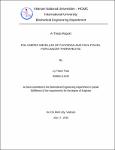| dc.description.abstract | The aim of this study was to synthesis polymeric micelles of Fucoidan (FC)
and Paclitaxel (PTX) for cancer therapeutic. To do this, amphiphilic polymer (FC-Arg-
LEV-PTX) was synthesized by covalent ester and amine linkage by chemical conjugation
and solvent evaporation method. The conjugated process use N-N’ -
Dicyclohexylcarbodiimide (DCC) as coupling agent in the presence of 4-
dimethylaminopyridine (DMAP). The micelles revealed a homogeneous spherical
morphology and size was analysis by Transmission Electron Microscopy (TEM). Fourier
transform infrared (FT-IR) spectroscopy was used to investigate the physicochemical
properties of the polymeric micelles. High-performance liquid chromatography (HPLC)
method was used to determine concentration of paclitaxel after in-vitro drug release test.
Fucoidan concentration was determined by conductometric titration method. This study
demonstrated amphiphilic polymer-paclitaxel conjugate (FC-Arg-LEV-PTX) could selfassemble
into micelles in an aqueous system with Arg-LEV-PTX block in the core and
FC in the shell. In addition, the result of in vitro release of paclitaxel and fucoidan show
that its release rate was higher at lower pH 4.5 than at pH 7.4. Finding effective drug
delivery system has the ability releasing two anticancer drugs as fucoidan and paclitaxel.
Furthermore, the current polymeric micelles may act as drug by circulating for prolonged
periods and extravasating from the vascular system, preferentially delivering drug to solid
tumors
Cancer nanotherapeutics has become an interesting subject of research in
many biomedical fields because nanotechnology can solve several limitations of
conventional drug delivery systems such as nonspecific biodistribution and targeting,
lack of water solubility, poor oral bioavailability, and low therapeutic indices. Moreover,
nanospheric particles have been proven as efficient drug delivery systems which are
submicronsized particles (3-200 nm), devices, or systems that can be made using a
variety of materials including polymers (polymeric nanoparticles, micelles, or
dendrimers), lipids (liposomes) viruses (viral nanoparticles), and even organometallic
compound for intravenous administration because of their comparatively long
bloodstream circulation [1, 2]. At the present time, polymeric micelles seem to be one of
the most advantageous carriers for the delivery of poorly water soluble drugs. Polymeric
micelles are composed of distinct two domains, a drug-loading core and a hydrophilic
shell amphiphilic block copolymers, containing a hydrophilic block and a hydrophobic
block, are firstly revealed to construct those distinct domains in a micelle structure
through spontaneous self-assembly as a result of hydrophobic interactions in aqueous
solution [3]. The hydrophilic and non-ionic polymer useful as the shell-forming block | en_US |


